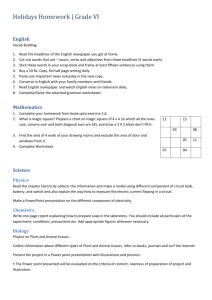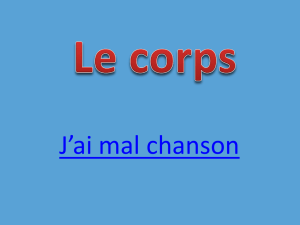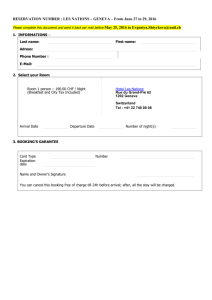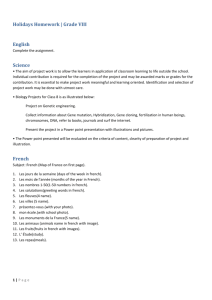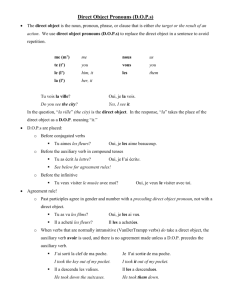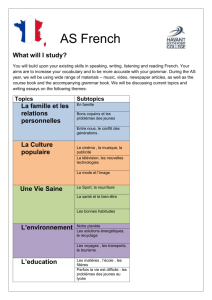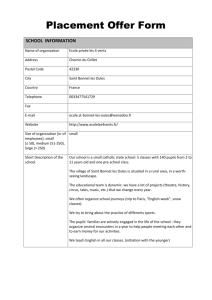INT 403 Unit Plan Outline
advertisement
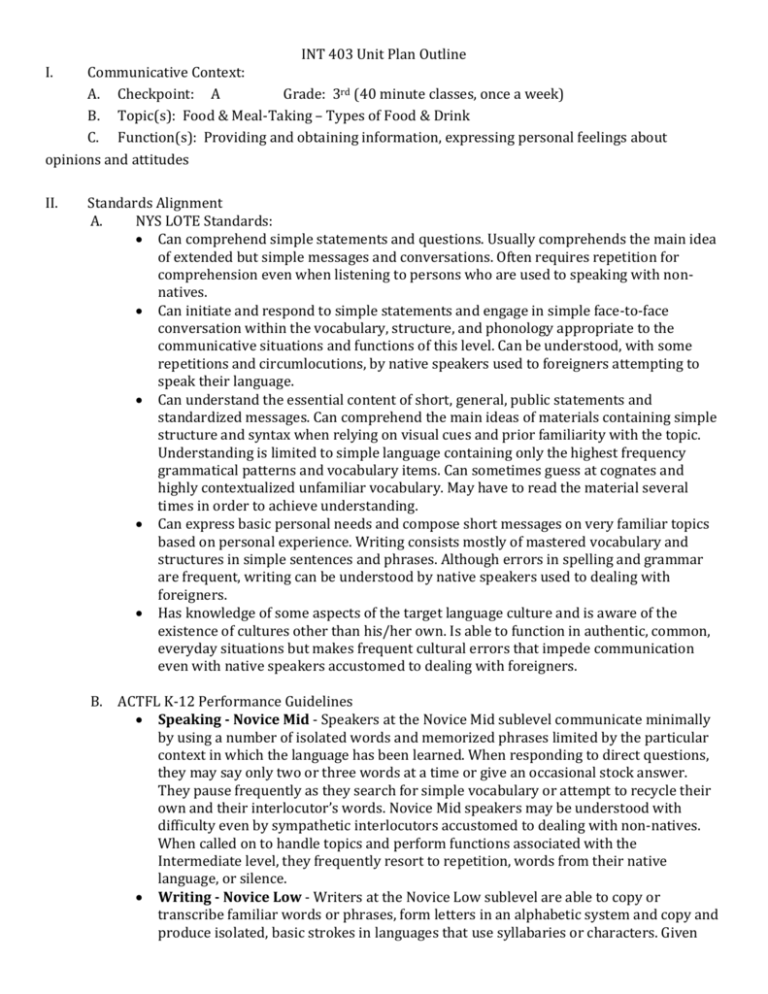
INT 403 Unit Plan Outline I. Communicative Context: A. Checkpoint: A Grade: 3rd (40 minute classes, once a week) B. Topic(s): Food & Meal-Taking – Types of Food & Drink C. Function(s): Providing and obtaining information, expressing personal feelings about opinions and attitudes II. Standards Alignment A. NYS LOTE Standards: Can comprehend simple statements and questions. Usually comprehends the main idea of extended but simple messages and conversations. Often requires repetition for comprehension even when listening to persons who are used to speaking with nonnatives. Can initiate and respond to simple statements and engage in simple face-to-face conversation within the vocabulary, structure, and phonology appropriate to the communicative situations and functions of this level. Can be understood, with some repetitions and circumlocutions, by native speakers used to foreigners attempting to speak their language. Can understand the essential content of short, general, public statements and standardized messages. Can comprehend the main ideas of materials containing simple structure and syntax when relying on visual cues and prior familiarity with the topic. Understanding is limited to simple language containing only the highest frequency grammatical patterns and vocabulary items. Can sometimes guess at cognates and highly contextualized unfamiliar vocabulary. May have to read the material several times in order to achieve understanding. Can express basic personal needs and compose short messages on very familiar topics based on personal experience. Writing consists mostly of mastered vocabulary and structures in simple sentences and phrases. Although errors in spelling and grammar are frequent, writing can be understood by native speakers used to dealing with foreigners. Has knowledge of some aspects of the target language culture and is aware of the existence of cultures other than his/her own. Is able to function in authentic, common, everyday situations but makes frequent cultural errors that impede communication even with native speakers accustomed to dealing with foreigners. B. ACTFL K-12 Performance Guidelines Speaking - Novice Mid - Speakers at the Novice Mid sublevel communicate minimally by using a number of isolated words and memorized phrases limited by the particular context in which the language has been learned. When responding to direct questions, they may say only two or three words at a time or give an occasional stock answer. They pause frequently as they search for simple vocabulary or attempt to recycle their own and their interlocutor’s words. Novice Mid speakers may be understood with difficulty even by sympathetic interlocutors accustomed to dealing with non-natives. When called on to handle topics and perform functions associated with the Intermediate level, they frequently resort to repetition, words from their native language, or silence. Writing - Novice Low - Writers at the Novice Low sublevel are able to copy or transcribe familiar words or phrases, form letters in an alphabetic system and copy and produce isolated, basic strokes in languages that use syllabaries or characters. Given adequate time and familiar cues, they can reproduce from memory a very limited number of isolated words or familiar phrases, but errors are to be expected. Listening - Novice Mid - At the Novice Mid sublevel, listeners can recognize and begin to understand a number of high-frequency, highly contextualized words and phrases including aural cognates and borrowed words. Typically, they understand little more than one phrase at a time, and repetition may be required. Reading - Novice Mid- At the Novice Mid sublevel, readers are able to recognize the letters or symbols of an alphabetic or syllabic writing system or a limited number of characters in a character-based language. They can identify a number of highly contextualized words and phrases including cognates and borrowed words but rarely understand material that exceeds a single phrase. Rereading is often required. All three modes will be addressed in this unit (interpersonal, interpretive, and presentational). III. Cultural Context: [Explain the cultural perspectives revealed and explored though the cultural products and practices (including authentic documents) that are examined during the unit.} IV. Student Outcomes: [Write “I can…” statements for each mode- Interpersonal, Interpretive and Presentational and include assessment activity to evaluate individual student achievement of each one. V. Curricular Tie-in ELA – Standard 1-Students will read, write, listen, and speak for information and understanding. VI. ELA standard 4 - Students will read, write, listen, and speak for social interaction. Vocabulary List Pre-supposed vocabulary from a prior unit Les numéros zero un deux trois quatre cinq six sept huit neuf dix et moins font Les couleurs rouge orange jaune vert bleu violet blanc noir General vocabulary Qu’est-ce que c’est? C’est… Combien de… est-ce qu’il y a? Oui Non Je ne sais pas. Est-ce que tu as… J’ai Petit grand J’aime (ça) Est-ce que tu aimes (ça)…? Il/elle aime Je n’aime pas (ça) Il/elle n’aime pas Je déteste Il/elle déteste Je préfère Est-ce que tu préfères …ou… Il/elle préfère Donnez-moi S’il vous plaît Merci De rien choisis, choisissez montre, montrez différent Retournez à vos pupitres. Prenez New Vocabulary Fruits les fruits les raisins un abricot, les abricots une banane, les bananes une fraise, les fraises une orange, les oranges une pêche, les pêches une poire, les poires une pommes, les pommes Vegetables les légumes une carotte, les carottes une tomate, les tomates un concombre, les concombres un champignon, les champignons les haricots verts Talking about food As-tu faim? j’ai faim je mange je voudrais Miscellaneous food le pain le fromage le jambon le croque-monsieur Desserts une crêpe, les crêpes la glace le gâteau un biscuit, les biscuits bon, bonne mauvais, mauvaise un bonbon, les bonbons Activity ideas Makes crepes in class for students – cultural lesson – map of France – Bretagne, sister city (Bretagne flag, color map of France and locate Paris and Rennes), show pictures of people making crepes) also eaten in Quebec, simply crepes in Rochester – visit from Pierre Heroux. Could also make “toques” for student chefs Students complete a math activity using food items (Sophie a deux pommes. Pierre a 5 pommes. Combien de pommes est-ce qu’il y a en total).
